How to See the Liberty Bell...in Queens
A copy of the famous American bell can be found inside a bank, which itself is modeled after Independence Hall!


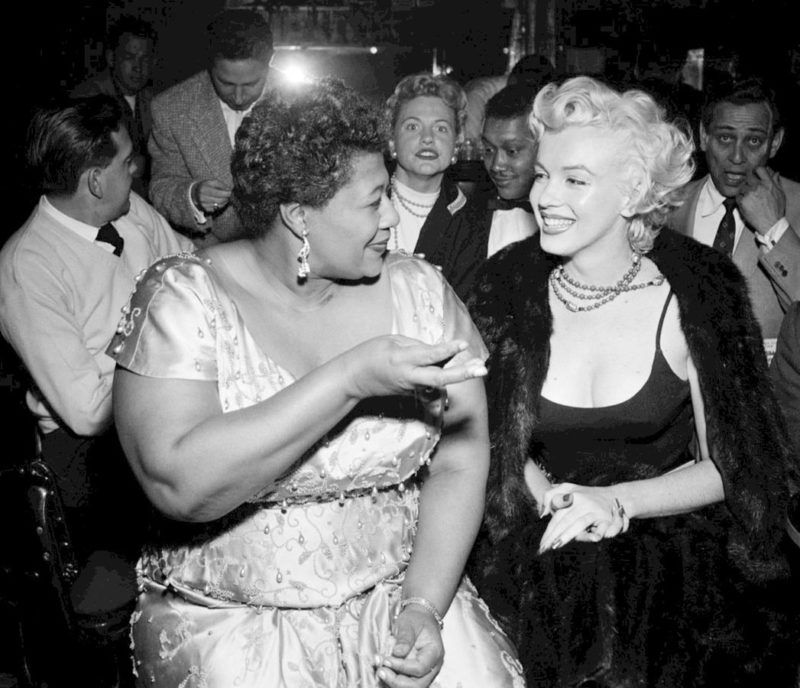
Ella Fitzgerald and Marilyn Monroe in 1954. Image via Wikimedia Commons
It’s no secret that since its inception, New York City has been the epitome of the American melting pot. Whether it was entered through the shores of Ellis Island, as the destination for migrants from the Southern Hemisphere, or even within the U.S. borders themselves, for generations, New York City has been the place where people from all walks of life have come together in pockets of community and havens of collaboration. As a result, it’s really no surprise that many famous figures in history found not only inspiration and a place to call home, but sometimes their best friends in New York City. A wide berth of people, including world-renown poets, artists, authors, mobsters, inventors, and even Presidents, formed close relationships in New York City. Here’s a list of how some historical figures and their equally formidable friends were perpetuated in New York City.
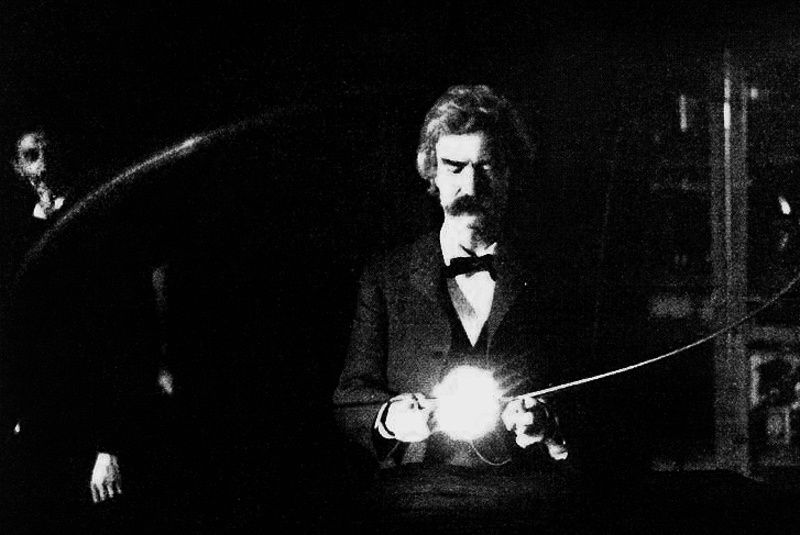
Mark Twain during Nikola Tesla’s human conduction experiment, with Tesla looking on in the background. Image via Wikimedia Commons.
An unlikely historical pairing, but quite the duo nonetheless, is Mark Twain and Austrian-Empire-born inventor/genius Nikola Tesla. After meeting on the New York City social scene during the Gilded Age, the two naturally inquisitive men formed an early bond. What started out as a simple letter exchange developed into a deep friendship involving quite a few home visits and hang out sessions to Tesla’s residence at the Waldorf Astoria and Tesla’s various labs.
In fact, as seen in a scientific article on Tesla’s work written back in 1895, a part of the research from Tesla’s early 1890’s electricity research required test subjects. He wanted to show the human body as a conductor of electricity, and the photographic evidence from that research features none other than Twain as the face in the images. Likewise, Tesla would assist Twain as well, reportedly even helping the writer get over a bad case of constipation thanks to one of Tesla’s inventions he called the “earthquake machine” (aka, a high frequency oscillator).
It also seems that Tesla had an equal admiration for Twain’s work as well. In his autobiography, My Inventions, Tesla writes:
“I had hardly completed my course at the Real Gymnasium when I was prostrated with a dangerous illness or rather, a score of them, and my condition became to desperate that I was given up by physicians. One day, I was handed a few volumes of new literature unlike anything I had read before and so captivating as make me utterly forget my hopeless state. They were the earlier works of mark Twain and to them might have been due to miraculous recovery which followed. Twenty-five years later, when I met Mr. Celemens and we formed a friendship between us I told him of the experience and was amazed to see that great man of laughter burst into tears.”

Widely accepted as a founding father of the Beatniks, On the Road author Jack Kerouac is credited by fellow beat writer John Clellon Holmes as the creator of the label “beat” itself. The term, which today conjures up images of free-love-preaching hippies and idealist anarchists, came about as the embodiment for the rock-bottom feeling and need for unhindered freedom of personal expression that Keoruac saw exuding from his mid 20th century New York City contemporaries.
On page 54 of On the Road, Kerouac wrote, “They were like the man with the dungeon stone and the gloom, rising from the underground, the sordid hipsters of America, a beat generation that I was slowly joining.” However, Kerouac didn’t spark this revolution on his own. The movement was the intellectual product of the deep friendship between Kerouac, Allen Ginsberg, and William Burroughs formed at Columbia College. Their collegiate journey together even took the trio through murder case charges as they helped mutual friend and fellow beat originator, Lucien Carr, dispose of the body of a love-smitten, stalker professor.
As explored by historian Jonah Raskin in his work American Scream, eventually the fresh landscape of San Francisco would also lead the friends to the famous beat hub, Six Gallery, but New York City was never very far. The Marlton Hotel at 5 West 8th Street is the 107-room property that was Kerouac’s home when he wrote The Subterraneans and Tristessa. Over the years, the Marlton has housed a number of creatives from poet Edna St. Vincent Millay to beloved actress Julie Andrews.
Other Noteable Beatnik writer locations include “Café Wah?” located at 115 MacDougal Street and Washington Square Park. “Cafe Wah?” was home of Beatnick open-mic nights for Beat musicians and authors alike, including Kerouac and Ginsberg as well as Bob Dylan. However, Washington Square Park is widely regarded as the epicenter of the Beatnik community. It became a Sunday tradition for Beatniks to meet at Washington Square Park to share their work and discuss ideas. The park was also the location of the famous Beatnik Riot of 1961, which was sparked when the New York City Department of Parks and Recreation Commissioner denied the Beatnik’s permit to play their music and share their work without just cause.
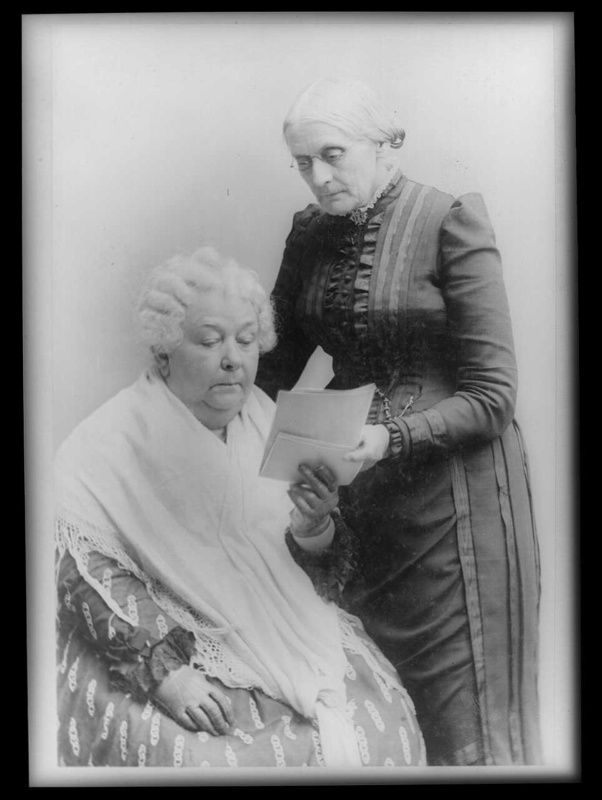
Susan B. Anthony and Elizabeth Cady Stanton. Image via Wikimedia Commons.
Credited as two of the most influential women’s rights figures are New York natives and women’s suffrage leaders Susan B. Anthony and Elizabeth Cady Stanton. Together, the women traveled the countryside hosting women’s rallies and events, even founding and running the independent women’s rights newspaper, The Revolution. However, it’s apparent that it was more than just a deep admiration for the cause that linked the two women together.
Another Suffragette, Anna Howard Shaw, wrote of the twosome in The Story of a Pioneer: “She [Miss Anthony] often said that Mrs. Stanton was the brains of the new association, while she herself was merely its hands and feet; but in truth the two women worked marvelously together, for Mrs. Stanton was a master of words and could write and speak to perfection of the things Susan B. Anthony saw and felt but could not herself express.”
Then, Stanton herself once professed in a letter to Anthony: “No power in heaven, hell or earth can separate us, for our hearts are eternally wedded together.” While the two women’s 50-year friendship didn’t exactly follow them to the grave, today the two women’s burial grounds can be visited relatively easily as Anthony rests in a Mount Hope Cemetery in Rochester, with Stanton a little closer to home in Woodlawn Cemetery in the Bronx. Soon, you might also be able to visit statues of the two women in Central Park, as outcries against the lack of female representation in the park have spurred on a fund for the cause.
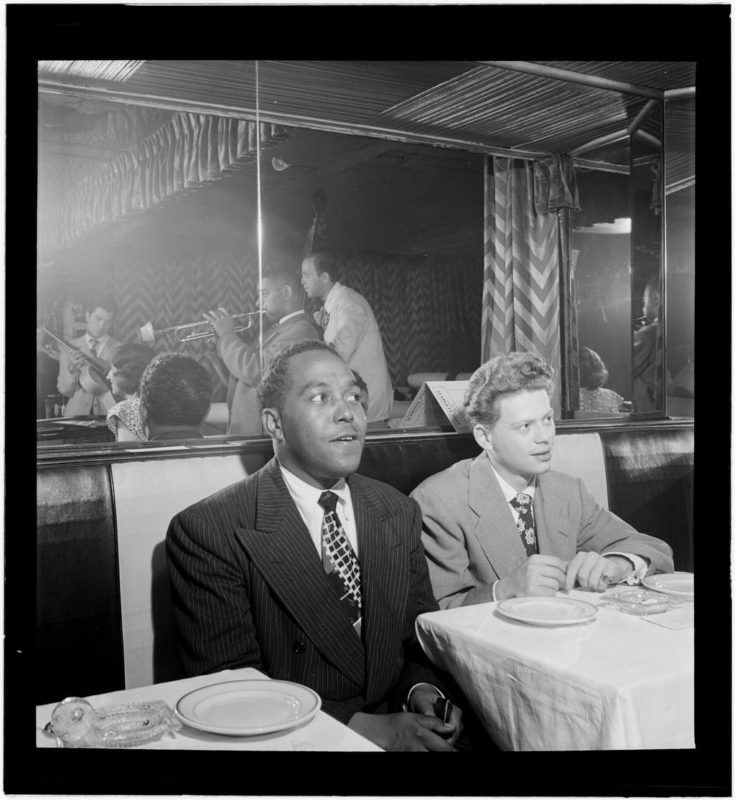
Charlie Parker (left) sits next to Red Rodney (right) as they watch Dizzy Gillespie (in mirror) perform at Downbeat, a Philadelphia progressive jazz club, in 1947. Image from the Library of Congress, photo taken by William Gottlieb via Wikimedia Commons.
Another beat generation duo, Charlie Parker and trumpeter Dizzy Gillespie, were among some of the New York City jazz scene’s most avid collaborations. Along with Miles Davis, they headed the New York City modern jazz movement, coined “Bebop,” that came to characterize the overall sound of the Beatniks and change the face of jazz itself. Recording many an album together, both live and in the studio, Parker and Gillespie quickly formed both a personal and musical bond. The New York Times obituary of Gillespie, written just after musician’s death in 1993, even recalls that Gillespie would refer to Parker as “the other side of my heartbeat,” along with crediting Parker as a sound-of-bebop innovator.
In his article “Dizzy Atmosphere”: The challenge of Bebop,” Dr. Eric Porter confirms that Parker and Gillespie were chief pioneers among the movement, and also speaks to Bebop as the musical manifestation of the Beatnik persona. He writes, “Not only did he development of the music itself reflect the forward-looking, worldly perspectives of many of its practitioners, but their public responses to the idea of bebop also spoke of the refusal of the artistic and social boundaries that inspired their music.
Although Parker and Gillespie met initially in Kansas City, it wasn’t long before they made their way to New York City, where they put that Bebop ideology to work. Minton’s Playhouse, located at 118th Street in Harlem, is broadly accepted as one of Bebop’s main birth places. Porter says Minton’s Playhouse was the “site of lengthy jam sessions where many of the musicians instrumental to the consolidation of bebop developed their techniques and musical ideas.” One such jam session includes Parker and Gillespie’s 1941 track “Kerouac,” inspired by the Beatnik leader himself.
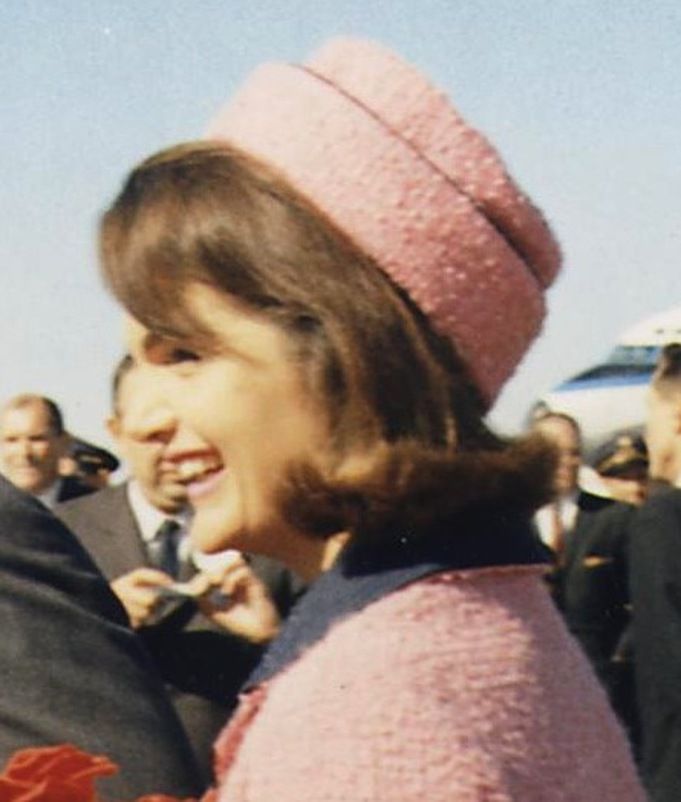
Jackie Kennedy in a signature pillbox hat by Halston. Image via Wikimedia Commons.
While perhaps more of a working relationship than a gossip-over-cocktails kind of friendship, the tie between internationally acclaimed designer (and notorious party-throwing bachelor) Halston and first lady Jackie Kennedy Onassis was vital to each another’s success and legacy. At the young age of 26 (and before he dropped the majority of his hame), Roy Halston Frowick made his way from Chicago to New York City with millinery skills as the only background for his fashion business. Luckily, his ability to make a hat would soon serve both him and Jackie pretty well. It was Halston who would design the First Lady’s signature pillbox hat, and the fact that it was on the head of the First Lady would make Halston’s hats signature.
At this time, the Kennedys were on the campaign trail, while Halston had left his frolicking mentor and friend, the eccentric designer Charles James, at the Chelsea Hotel to go work for Bergdorf Goodman. Meanwhile, the future First Lady needed hats for the road. It was her almost vehement distaste for hats altogether due to her large head that solidified her and Halston’s relationship– they had the same size head.
It wasn’t long before the pillbox hat would become Jackie’s hat of choice. “I remember the day Halston brought the pillbox to Mrs. Kennedy at the Carlyle,” said President of Bergdorf Andrew Goodman. “You’re so young to be so successful,’” she replied to him. Kennedy reportedly even cried when she had to tell Halston that her husband had made a promise to a different designer for the honor of creating her inauguration look.
Thus, Jackie Kennedy became a fashion icon and Halston put his name irrevocably on the fashion map. Halston’s salon subsequently took off and soon was the go-to spot for New York City’s elite. Everyone from the likes of Lauren Bacall and Bianca Jagger to Barbara Walters would come to his salon for lavish lunches and make their way to the now-New York City landmark Halston House for swanky soirees.
On a side note, quite the opposite of a friend actually, would become a stalker of Jackie’s. This was the infamous paparazzo Ron Gallela, who used to troll around her Fifth Avenue apartment before she filed a restraining order.
The Abstract Expressionist Movement was again another manifestation of the Beat Generation, but this time through the avenue of the visual arts. It would be the tenacity and boldness of the post World War II movement that would move the epicenter of fine art from Paris to New York City.
Although not necessarily considered at the forefront of the movement (Jackson Pollock or William de Kooning are generally thought of as the expressionist heavy hitters), both Hartigan and Frankenthaler were deep in the mix. They not only provided arguably the strongest female voices within the male-dominant fine art movement, but also shared a deep connection with each other.
As seen first-hand in a 1968 Oral history interview with Helen Frankenthaler from the Smithsonian’s archive of American art, the two women spent the budding of their abstract expressionist careers side-by-side. Hartigan was among the very first group of New York City artists, as Frankenthaler’s then boyfriend, art critic Clement Greenberg, would introduce her in 1950. From there, the two were in their first group show together for John Meyer’s studio the following year and continued on, solidifying themselves in the “The Artist’s Club.” Located at 39 East 8th Street, Frankenthaler recalls that “The Club” was where her and her comrades in expressionism would go Friday evenings as a place for discussion and criticism.
Another notable abstract expressionist hangout was The Cedar Bar. Although originally located at 24 University Place, Cedar Tavern as it’s currently called, now resides at 82 University Place. Next to “The Club,” artist and club veteran, Jeanne Miles, describes The Cedar Bar as “a home away from home” for many of the artists. “The talk was always about art, and there were fights, but the issues were aesthetic,” Miles said. “The atmosphere provided nourishment for many struggling artists who later became successful.”
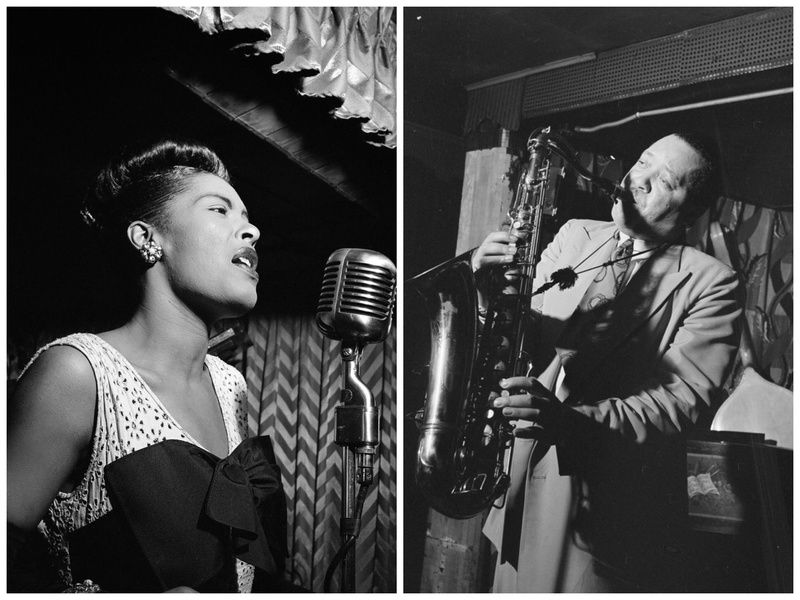
Billie Holiday (left) at the Downbeat club, a jazz club in New York City, in 1947. Portrait of Lester Young (right) at the Famous Door in 1946. Images by William P. Gottlieb from the Library of Congress
The connection between iconic jazz singer Billie Holiday and saxophonist Lester Young certainly isn’t an anomaly, as they came up right around the same time in the New York City jazz scene. But it’s mildly surprising how deep, lasting, and platonic their friendship was. Young and Holiday first met in jazz clubs around New York City such as the Lenox Lounge and eventually the Apollo theatre starting in 1934– the year Young moved to the city to join Fletcher Henderson’s group. That same year, Young moved in with Holiday into the Harlem Hotel when a rat was discovered running around his Harlem apartment. From that moment forward, their friendship took off in a way that was “publicly recognized during their lifetime.” It would be Young who coined the popular epithet for “Lady Day,” and then Holiday who would give Young his nickname “Prez.”
Together, they created some of Holiday’s earliest hits including A Sailboat in the Moonlight. This session, according to mutual friends and producer George Avakian, “is really the one that expresses their closeness musically and spiritually more than any other.”
Holiday and Young rose together, but would also unfortunately fall together as they both went on to fight insurmountable battles against drug and alcohol addition. The musicians died just two months apart in the summer of 1959.
Greatly inspired by the original beatniks, rock-and-roll-hall-of-fame-musician Patti Smith and fine-artist-turned-photographer Robert Mapplethorpe found one another in 1967 through several chance encounters on the streets of New York City, where they eventually choose to fuel each other’s careers as well as their beatnik spirits. Together they evolved as artists as they collected the diverse creative skills they’ve been critically acclaimed for. Although Mapplethorpe stayed relatively steady in the lane of visual arts, Smith, along with being a famed musician, has written several award-winning books and has had many exhibitions of her drawings. The two artists are undeniably icons on their own, but perhaps even more cosmic as a duo.
Deeply explored in Smith’s 2010 National Book award winning memoir Just Kids, the relationship between Smith and Mapplethorpe is shown to have been complicated but eternal. Smith helped Mapplethorpe as he came to terms with his sexuality and his eventual contraction of HIV, while Mapplethorpe helped Smith take her first steps of artistic self-discovery. They were together for Smith’s initial musical career awakening moment post her first Doors concert, they were together when Mapplethorpe’s idol, Andy Warhol, was shot, and though connected only through a phone line, they were together the night before AIDS took Mapplethorpe’s life in 1989. Although separated at times throughout their careers, they remained inseparable friends till Mapplethorpe’s final day.
In a brief, but illuminating note to her readers preceding the opening of Just Kids, Smith discusses the controversy surrounding Mapplethorpe and his intense devotion to his art.
Smith writes: “Much has been said about Robert, and more will be added. Young men will adopt his gait. Young girls will wear white dresses and mourn his curls. He will be condemned and adored. His excesses damned or romanticized. In the end, truth will be found in his work, the corporeal body of the artist. It will not fall away. Man cannot judge it. For art sings of God, and ultimately belongs to him.”
Hotel Chelsea, which is famous for housing several artists from all categories, became the home and saving grace of Smith and Mapplethorpe in 1969. Smith was desperate to get Mapplethorpe, who had fallen extremely ill, out of their dingy former apartment and was able to secure the smallest room in the hotel, room 1017, by selling some of her work. During their time at the hotel, they were greatly influenced and inspired by their fellow residents, including Janis Joplin, Gregory Coroso, and Allen Ginsberg.
Another notable Smith-Mapplethorpe location is Tompkins Square Park. Although Smith and Mapplethorpe had two brief encounters prior to running into one another at the park and would part ways yet again after this meeting, the park was the location of one of their most crucial encounters. Feeling unsafe on a date with an older writer and looking for an escape, Smith latched on to the vaguely familiar face of Mapplethorpe, who went along with Smith’s ruse to cast him as her boyfriend. The park would also serve as a temple of sorts for the punk movement, which cast Smith as their Queen.
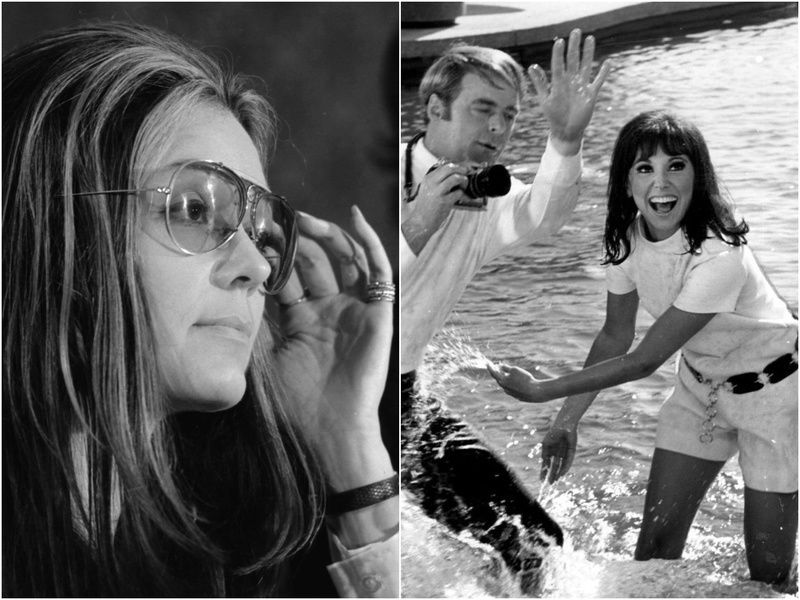
Gloria Steinem (left) at the news conference, Women’s Action Alliance. Photo of Garry Marshall (right) as a fashion photographer and Marlo Thomas as Ann-Marie from the television program That Girl. Images via Wikimedia Commons users Tom and We hope.
The other pioneers of the women’s rights movement (but this time for feminism’s second lap around the block), are activists and icons Gloria Steinem and Marlo Thomas, who became fast friends in perhaps the most fitting way possible for such fiery feminists. As Marlo Thomas recalls, she and Steinem were brought together in meetings after Thomas’ first successful season of That Girl was wrapping up in 1967. The agent wanted Thomas to portray the part of Steinem in a biopic about the then-recent revelation of Steinem’s time as the undercover journalist in the Playboy mansion. That’s when the agent, according to Thomas, made his fatal flaw. As Thomas writes in her article, A Candid Conversation With Gloria Steinem:
“A meeting was set up by the agent, and no more than thirty seconds into it, he beamed at us appreciatively from across his desk, and delivered that jaw-dropping hello.
‘Boy, I don’t know which one of you I’d like to f**k first.’
Boy, did he pick the wrong two women to say that to. I don’t think we heard anything else he said that day. The meeting — and the idea — came to an immediate end. But for Gloria and me, it was just the beginning.”
That conversation, did indeed mark “just the beginning” between Thomas and Steinem and the work they would do together. Along with fellow women’s rights activists, Patricia Carbine and Letty Cottin Pogrebin, together they would go on to found the Ms. Foundation in 1972– the first and still one of the largest women’s funds in the country. The Ms. Foundation has remained in New York City throughout the duration of its existence, first headquartered in Manhattan before it made a move in 2008 to its current flagship office at the Metro Tech Center in the outskirts of Brooklyn Heights.
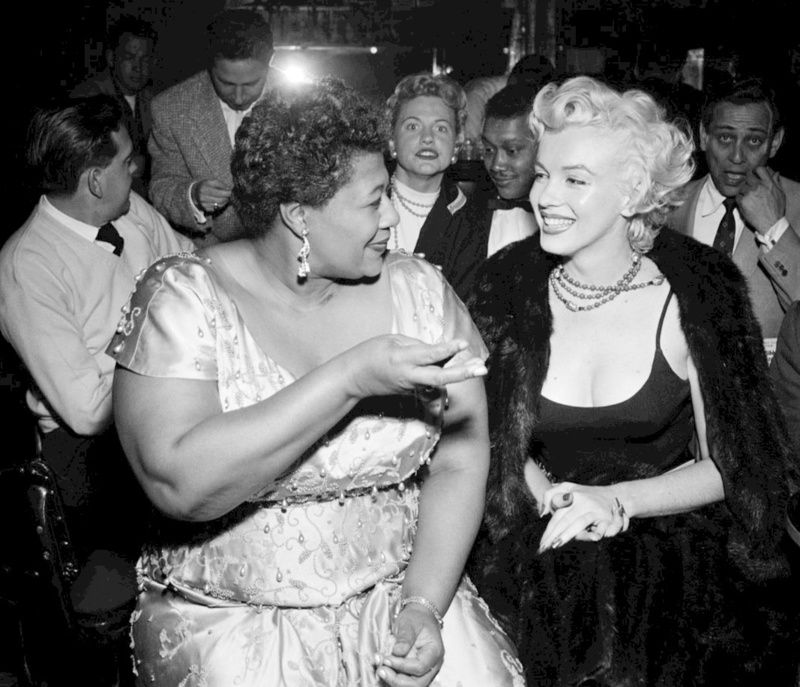
Ella Fitzgerald and Marilyn Monroe at Tiffany Club in 1954. Image via Wikimedia Commons.
Marilyn Monroe and Ella Fitzgerald are one set of friends with quite the unique story. In essence, it was really Monroe’s deep love for Fitzgerald’s music that connected the two women at all. Monroe was shocked when she learned that one of her favorite (and also one of the most famous) jazz clubs in L.A.– The Mocambo– wouldn’t let Fitzgerald perform due to her race. At this point, the year was 1955 and the likes of Frank Sinatra, Charlie Chaplin, and Lauren Bacall were all staples of the club. Using her celebrity for good, Monroe called up the owner of The Mocambo and demanded that Fitzgerald be allowed to perform.
Though the relationship between Fitzgerald and Monroe certainly has one of the more subtle connections to New York, the city nonetheless is what sparked the friendship. It was because of the time Monroe spent in the city– taking a hiatus from her home in Los Angeles– that she first discovered and fell in love with Fitzgerald’s music. As Michelle Morgan recounts in her work Marilyn Monroe: Private and Confidential, Monroe’s vocal couch Hal Schaefer assigned Monroe to listen to Fitzgerald’s album in order to learn how to sing in tune. “This first lesson would lead to a life-long love of Ella’s music, which would eventually spill over to love for the artist herself,” writes Morgan.
Later, Fitzgerald recalls the feelings she had for Monroe and the part she played in forming Fitzgerald’s career:
“I owe Marilyn Monroe a real debt … she personally called the owner of The Mocambo, and told him she wanted me booked immediately, and if he would do it, she would take a front table every night. She told him—and it was true, due to Marilyn’s superstar status—that the press would go wild. The owner said yes, and Marilyn was there, front table, every night. The press went overboard. After that, I never had to play a small jazz club again. She was an unusual woman—a little ahead of her times. And she didn’t know it.”
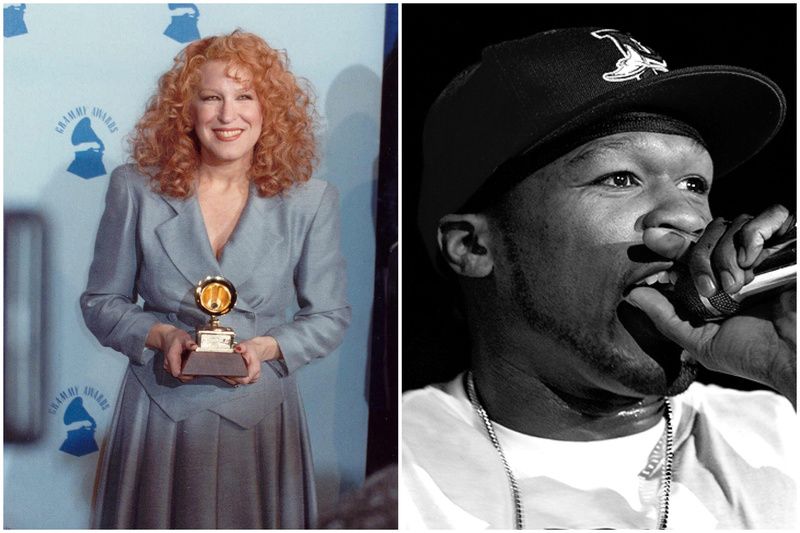
Photo of Bette Midler (left) backstage at the Grammy Awards in 1990. Image via Wikimedia Commons user Alan Light. Rapper 50 Cent in concert (right). Image via Wikimedia Commons user Alex Cons.
While not quite falling under the “historic” category, we couldn’t resist mentioning that Broadway superstar Bette Midler and rapper Curtis “50 Cent” Jackson might be starting what the next century will refer to as their famous New York City friendship. The friendship started when Jackson joined the New York Restoration Project, which Midler founded in 1995. According to Vanity Fair, Midler said of her pal. ‘I love him; he’s a doll.'” She also told E!, that Curtis didn’t even ask about the price tag before joining the project. He just asked, “Where do sign?”
Real quickly, we’d also like to mention that 50 Cent has been seen hanging out with Meryl Streep as well– court side at a Lakers versus Knicks game–and let’s not even start on Snoop Dog and Martha Stewart or their TV show.
Next, check out:5 Authors Who Crafted Novels Around the Culture and Influence of NYC and 8 NYC Homes of Famous Writers from Truman Capote to Edith Wharton. Get in touch with the author: @Erika_A_Stark.
Subscribe to our newsletter